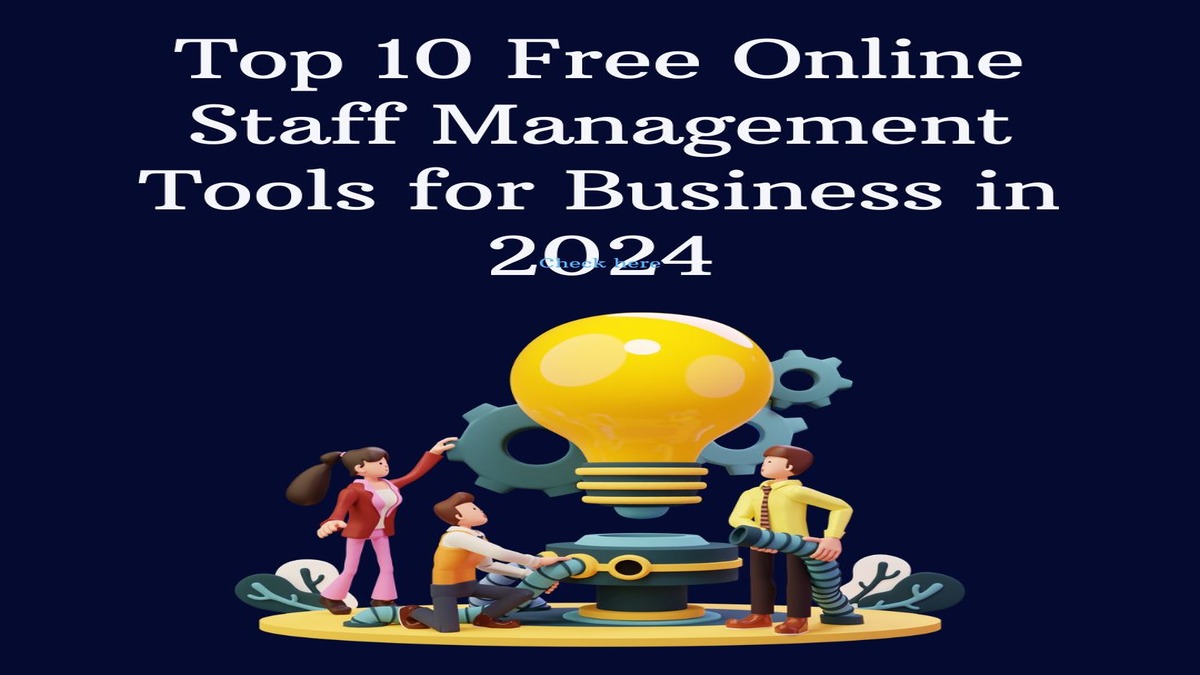In today’s fast-paced business world, managing your staff effectively is more important than ever. The right tools can make a huge difference in your team’s workflow, communication, and overall productivity—all without costing a fortune. This article will look at the top 10 free online staff management tools available in 2024, highlighting their key features to help your business thrive.
What is Staff Management Software?
Online staff management software, also known as workforce management software or human resource management systems (HRMS), is a digital solution designed to help businesses efficiently manage their employees and streamline various HR-related tasks. These cloud-based platforms provide tools and features that assist in organizing, tracking, and optimizing various aspects of workforce management.
Key Factors in Online Staff Management Software
Here are some key aspects of online staff management software:
- Employee Information Management:
- Centralized database for storing employee details
- Easy access to employee records, contracts, and documents
- Time and Attendance Tracking:
- Digital time clocks or punch-in systems
- Absence and leave management
- Overtime tracking
- Scheduling:
- Shift planning and management
- Employee availability tracking
- Automatic schedule generation based on business needs and employee preferences
- Performance Management:
- Goal setting and tracking
- Performance reviews and feedback systems
- Skills and training management
- Communication:
- Internal messaging systems
- Announcement boards
- Employee self-service portals
- Payroll Integration:
- Time data integration with payroll systems
- Salary and benefits management
- Reporting and Analytics:
- Generation of HR reports
- Workforce analytics for data-driven decision making
- Compliance:
- Ensuring adherence to labor laws and regulations
- Managing certifications and required training
- Recruitment and Onboarding:
- Applicant tracking systems
- New hire onboarding processes
- Mobile Accessibility:
- Apps for employees to access schedules, request time off, etc.
- Manager tools for on-the-go workforce management
Benefits of Using Online Staff Management Software for Business
The primary benefits of using online staff management tools include:
- Improved efficiency in HR processes
- Reduced administrative workload
- Enhanced communication between management and employees
- Better oversight of workforce productivity
- Increased accuracy in time tracking and payroll
- Improved employee satisfaction through self-service features
- Data-driven insights for strategic decision-making
Key Factors to Consider When Choosing Staff Management Tools
When selecting the right staff management tools for your business in 2024, there are several crucial factors to consider:

1. Understanding Your Team’s Needs
- Assess your team’s specific needs, workflow, and project complexity
- Consider the size of your team and the nature of your workflow
- Evaluate the collaboration features required, such as file sharing, communication tools, and task assignment
2. Essential Features
- Task assignment and tracking
- Integration capabilities with other tools
- Customization and scalability options
- Compliance management and security measures
- Skill tracking and employee scheduling
3. Considering Budget and ROI
- Conduct a cost-benefit analysis to ensure the software’s value
- Compare subscription models vs. one-time purchases
- Be aware of potential hidden costs, such as fees for additional users or support
4. Evaluation Strategies
- Take advantage of free trials and demos to test the software’s functionality
- Read user reviews and feedback from similar teams or industries
- Create a comparison chart of your top software choices
5. Integration Capabilities
- Ensure the staff management tool can integrate with your existing systems and workflows
- Look for tools that offer seamless integration with communication platforms, project management software, and HR systems
By considering these key factors, you can make an informed decision and choose the best staff management tools for your business in 2024. Prioritize features that align with your team’s needs, stay within your budget, and offer a strong return on investment through improved efficiency and productivity.
List of Free Online Staff Management tools Software for Businesses
Here is an overview of the top free online staff management systems, including their best uses and pricing details:
1.Planday
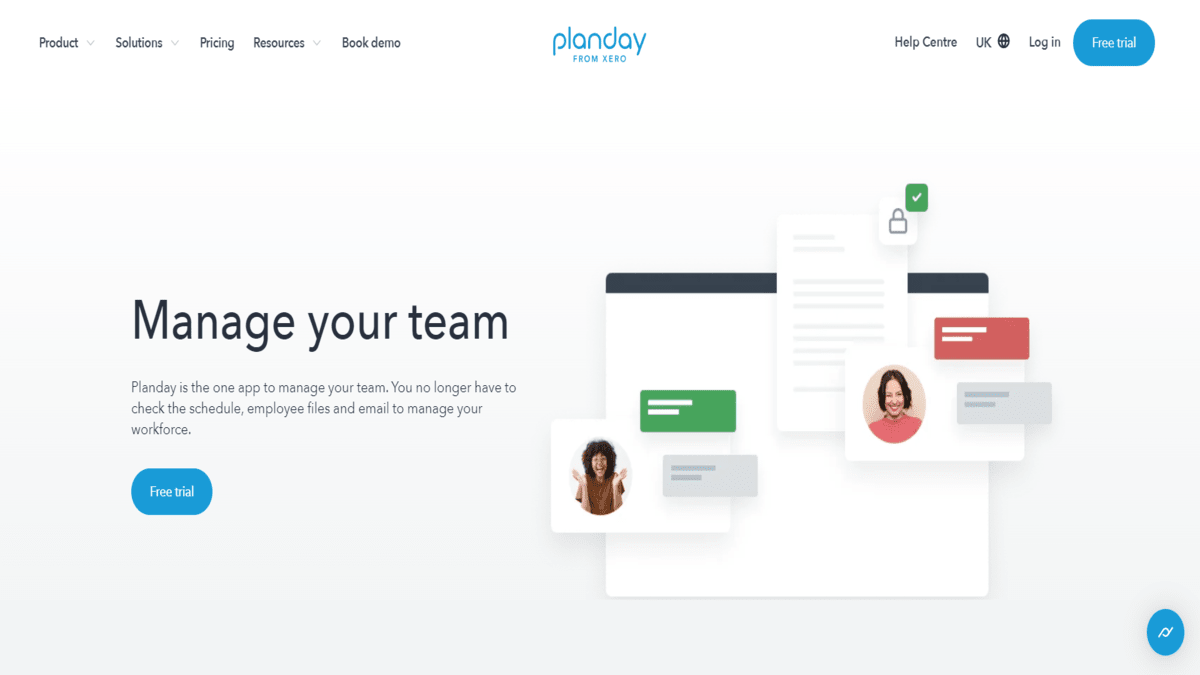
Planday is an online platform designed to streamline workforce management, especially in hospitality and healthcare. It helps businesses manage employee availability, schedule shifts, and track time, ensuring compliance with labor laws. The software includes tools for communication, shift swapping, and reporting, making team collaboration easier. Planday reduces administrative tasks and errors, saving businesses time and money while boosting employee engagement and customer service. With its user-friendly interface, Planday enables companies to focus on their core operations while efficiently managing their staff.
Key Features:
- Employee Scheduling: Create and manage staff schedules.
- Time Tracking: Track employee hours and attendance.
- Shift Swapping: Allow staff to swap shifts easily.
- Time-Off Requests: Manage and approve employee leave requests.
- Communication Tools: Facilitate internal team communication.
- Compliance Management: Ensure adherence to labor laws and regulations.
Pricing Details:
Planday offers a 30-day free trial that allows users to explore its staff management features without any financial commitment.
2. Connecteam
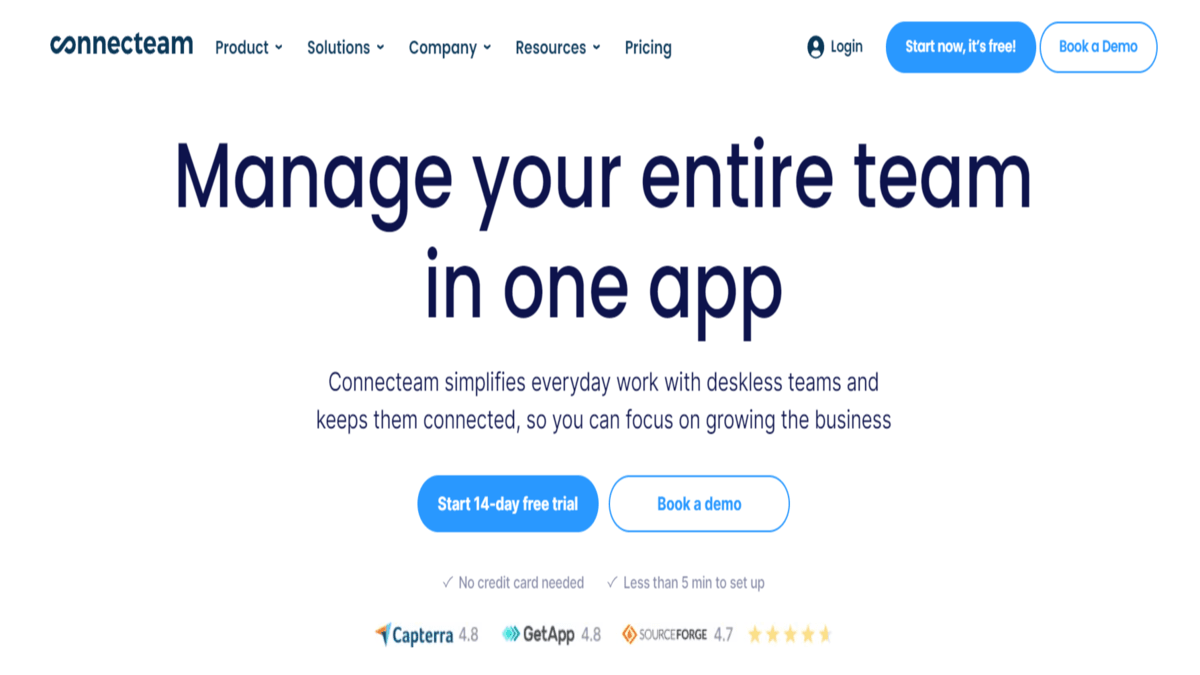
Connecteam is an all-in-one employee management app designed for deskless workers. It offers tools for communication, scheduling, task management, and training, all in one platform. The app helps businesses streamline operations, improve team collaboration, and boost productivity. It’s particularly useful for companies with mobile or remote teams. Connecteam simplifies workforce management by keeping everything accessible from a mobile device.
Key Features:
- Employee Scheduling: Create and manage work schedules.
- Time Tracking: Track employee hours and attendance.
- Task Management: Assign and track tasks and projects.
- Internal Communication: Chat and share updates with your team.
- Document Management: Share and store important documents.
- HR Management: Handle onboarding, training, and employee records.
- Custom Forms: Create and manage forms and checklists.
Pricing Details:
Connecteam’s free plan supports up to 10 users, making it ideal for small businesses or departments.
3.OrangeHRM
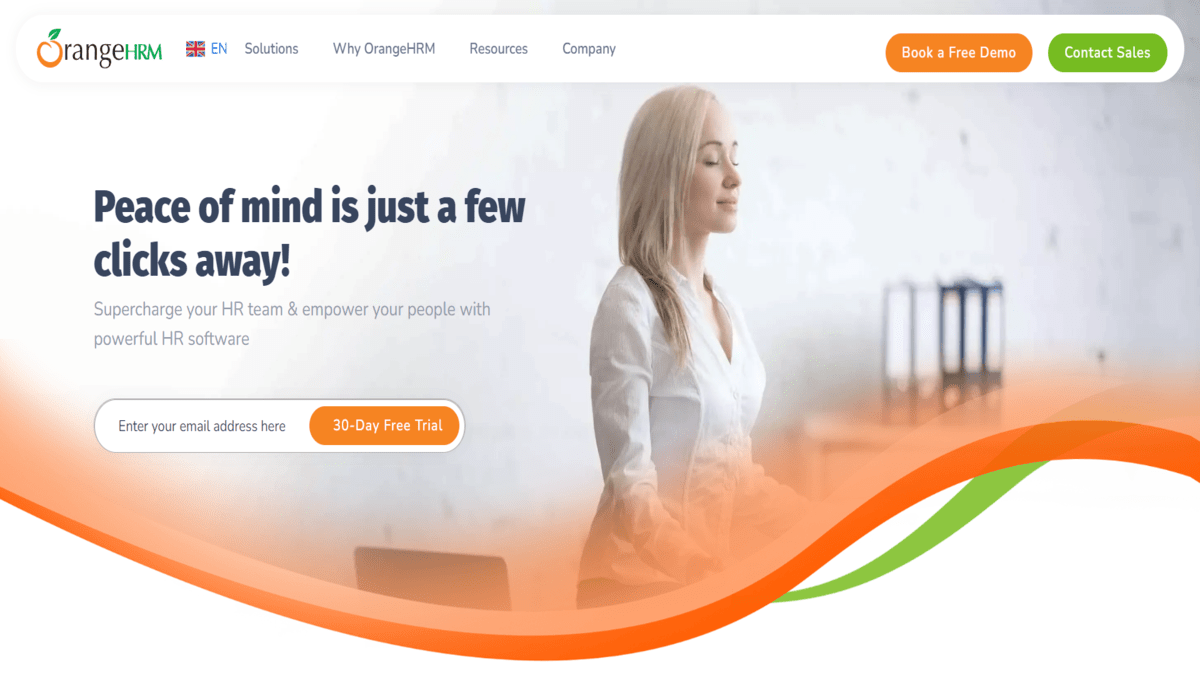
OrangeHRM is an open-source human resource management software. It helps businesses manage various aspects of their workforce, from employee information to time tracking. The system offers modules for core HR functions, leave management, recruitment, and performance evaluation. OrangeHRM comes in two versions: a free self-hosted option and a paid cloud-based service with additional features. It’s designed to streamline HR processes for companies of various sizes, from small businesses to large enterprises.
Key Features
- Employee Information Management: Stores and organizes employee data, including personal details, job information, and documents.
- Leave Management: Tracks and manages employee time off, vacation requests, and leave balances.
- Time and Attendance: Monitors employee work hours, shifts, and attendance records.
- Recruitment: Supports the hiring process with applicant tracking and job posting features.
- Performance Management: Facilitates employee evaluations, goal setting, and performance reviews.
Pricing Details:
OrangeHRM provides a cloud-based version with a 30-day free trial, after which pricing starts based on the number of employees.
4. Zoho People
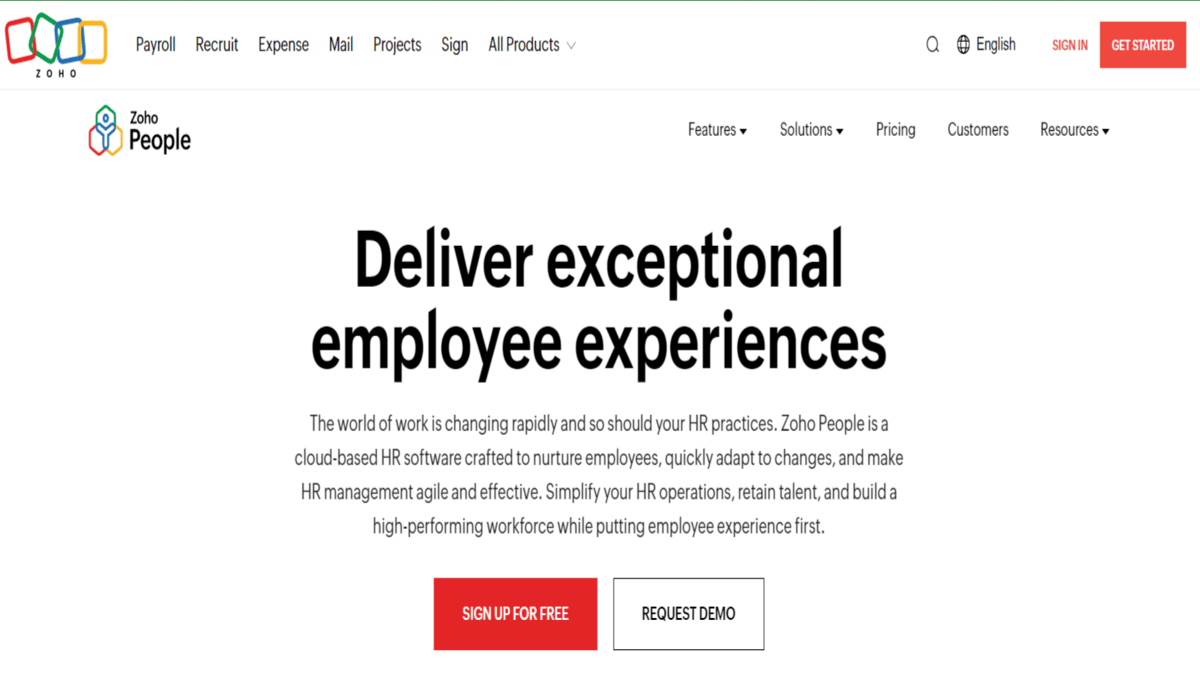
Zoho People is an online software for managing employees. It helps businesses keep track of worker information and schedules. The tool makes it easy to handle time off, attendance, and job performance. It can be used by small and large companies to organize their workforce. Zoho People offers some free features for small teams and paid options for bigger businesses.
Key Features:
- Employee Database: Store and manage employee details in one place.
- Leave Management: Handle leave requests and track balances.
- Attendance Tracking: Monitor employee attendance and time.
- Performance Reviews: Set goals, conduct appraisals, and review performance.
- Recruitment: Manage job postings, applications, and hiring processes.
- Onboarding: Simplify the onboarding process for new hires.
Pricing Details
Zoho People’s free plan supports up to 5 users and offers core HR management features. Its integration with other Zoho products makes it an attractive option for businesses already using the Zoho ecosystem.
5. Homebase
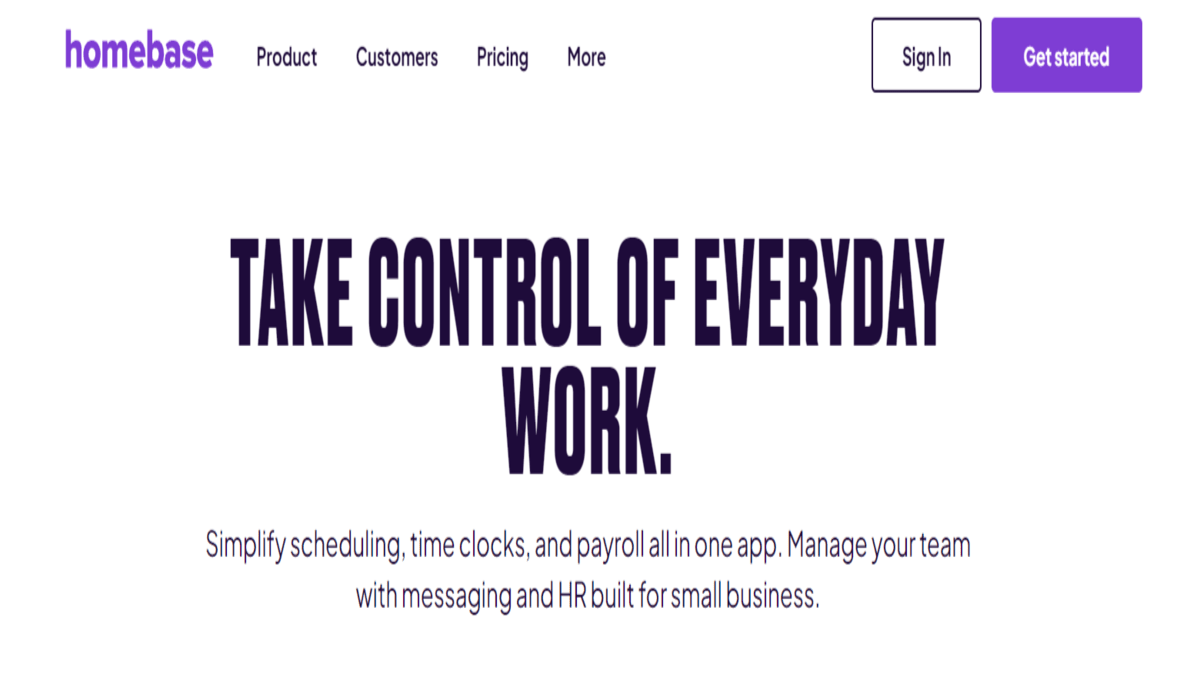
Homebase is a workforce management software designed for small businesses. It simplifies employee scheduling, time tracking, and payroll management. The platform also offers tools for hiring, team communication, and compliance, helping businesses manage their staff more efficiently. Homebase is accessible via mobile and desktop, making it easy for both managers and employees to stay connected. It’s particularly popular in industries like retail, hospitality, and food service.
Key Features:
- Employee Scheduling: Create and manage staff schedules.
- Time Tracking: Track employee hours and attendance.
- Leave Management: Handle time-off requests and approvals.
- Team Communication: Share updates and messages with staff.
- Hiring Tools: Post job openings and manage applications.
- Payroll Integration: Sync with payroll systems for easy pay processing.
Pricing Details:
Homebase offers a robust free plan for businesses with a single location for up to 20 employees. It’s particularly well-suited for restaurants, retail stores, and other businesses with hourly employees and complex scheduling needs.
6.Sling
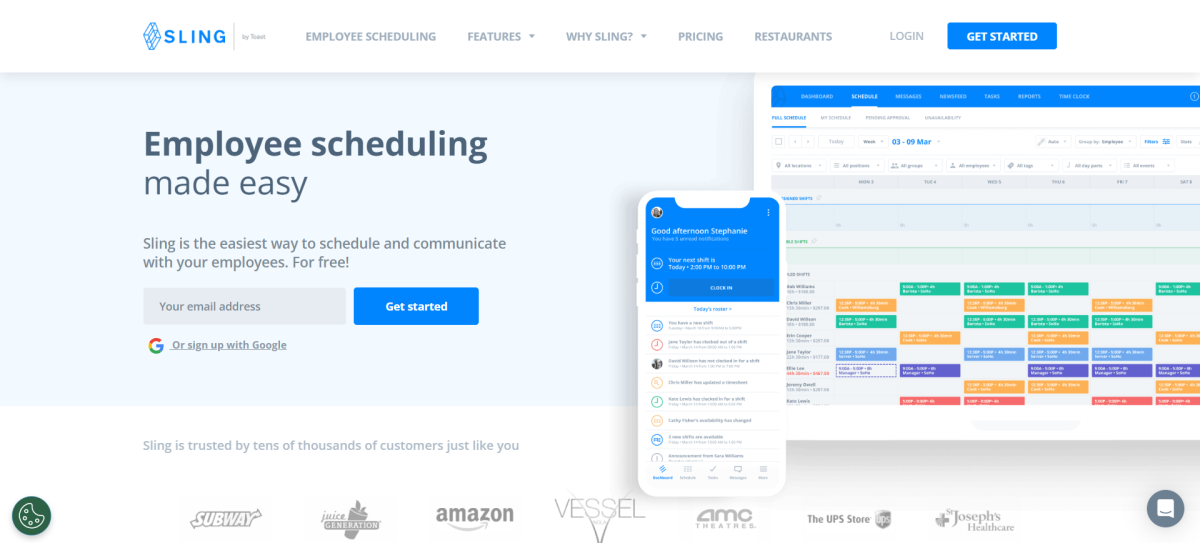
Sling is a workforce management platform for scheduling and communication. It helps businesses create schedules, track hours, and manage time-off requests efficiently. Ideal for hospitality and retail, Sling offers shift swapping, notifications, and labor cost tracking. The user-friendly platform is accessible on various devices, making management easy for both managers and employees.
Key Features
- Employee Scheduling: Create and adjust schedules easily.
- Time Tracking: Record and monitor employee hours.
- Shift Swapping: Allow employees to swap shifts with approval.
- Time-Off Requests: Manage requests for vacations and time off.
- Internal Communication: Share updates and messages with the team.
- Notifications: Get alerts for shift overlaps and schedule changes.
Pricing Details:
Sling offers a free plan for up to 50 users with unlimited features.
7. TimeCamp
![]()
TimeCamp is a time tracking software designed to help businesses monitor employee work hours and project progress. It offers features like automatic time tracking, timesheets, invoicing, and productivity reports. The platform integrates with various project management and collaboration tools, making it easier to manage tasks and billing. TimeCamp is useful for freelancers, teams, and companies looking to improve productivity and streamline time management.
Key Features:
- Time Tracking: Log work hours manually or automatically.
- Project Management: Track time spent on different projects and tasks.
- Timesheets: Generate and manage timesheets easily.
- Invoicing: Create and send invoices based on tracked time.
- Reporting: Generate detailed reports on time usage and productivity.
- Integrations: Connect with various third-party apps and tools.
Pricing Details:
TimeCamp offers a free plan for unlimited users with basic time tracking and productivity features. While it’s not a comprehensive HR solution, it’s an excellent tool for businesses focused on improving time management and productivity.
8. Asana
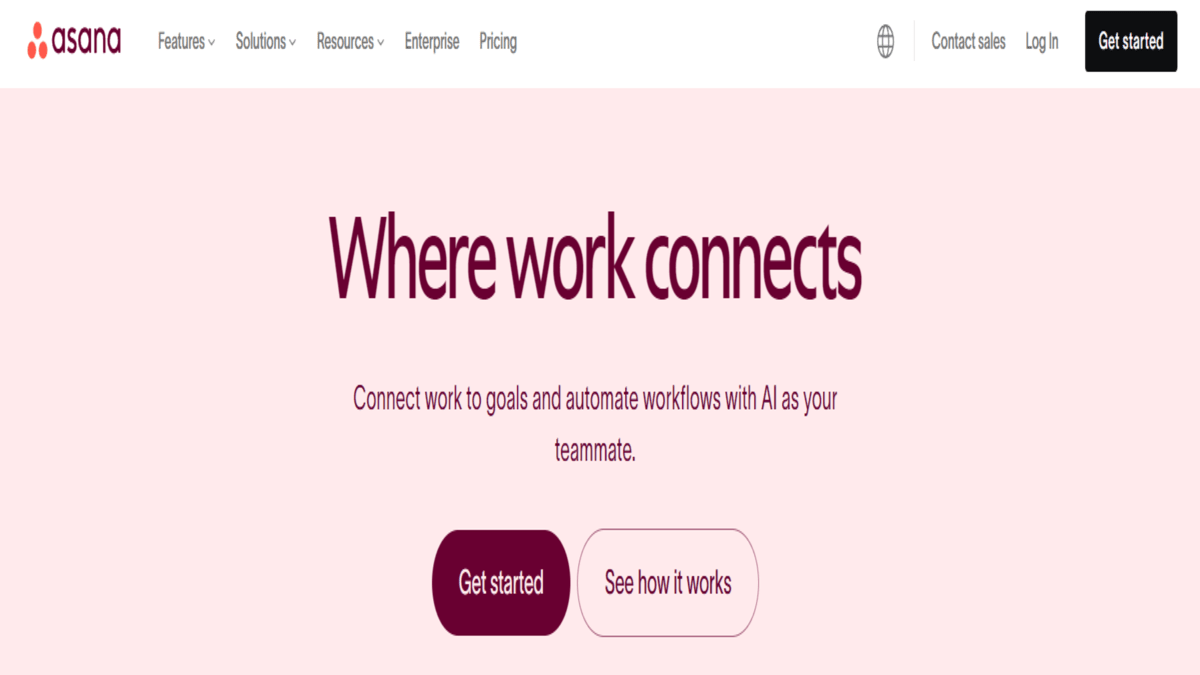
Asana is a collaborative work management platform designed to help teams organize and track their projects efficiently. It allows users to create tasks, set deadlines, and assign responsibilities, ensuring clarity and accountability within teams. By centralizing communication and project management, Asana reduces the need for lengthy email chains and status meetings. The platform is user-friendly and integrates with various tools, enhancing overall productivity. Asana aims to streamline workflows and improve team collaboration across different industries.
Key Features:
- Task Management: Create and assign tasks with deadlines and priorities.
- Project Tracking: Organize tasks into projects with timelines and milestones.
- Collaborative Workspaces: Share projects and tasks with team members.
- Due Dates & Reminders: Set due dates and receive reminders for tasks.
- Progress Tracking: Visualize progress with boards, lists, and timelines.
- File Attachments: Attach files and documents to tasks for easy access.
Pricing Details
Asana’s free plan supports up to 10 team members with unlimited tasks and projects.
9. Factorial
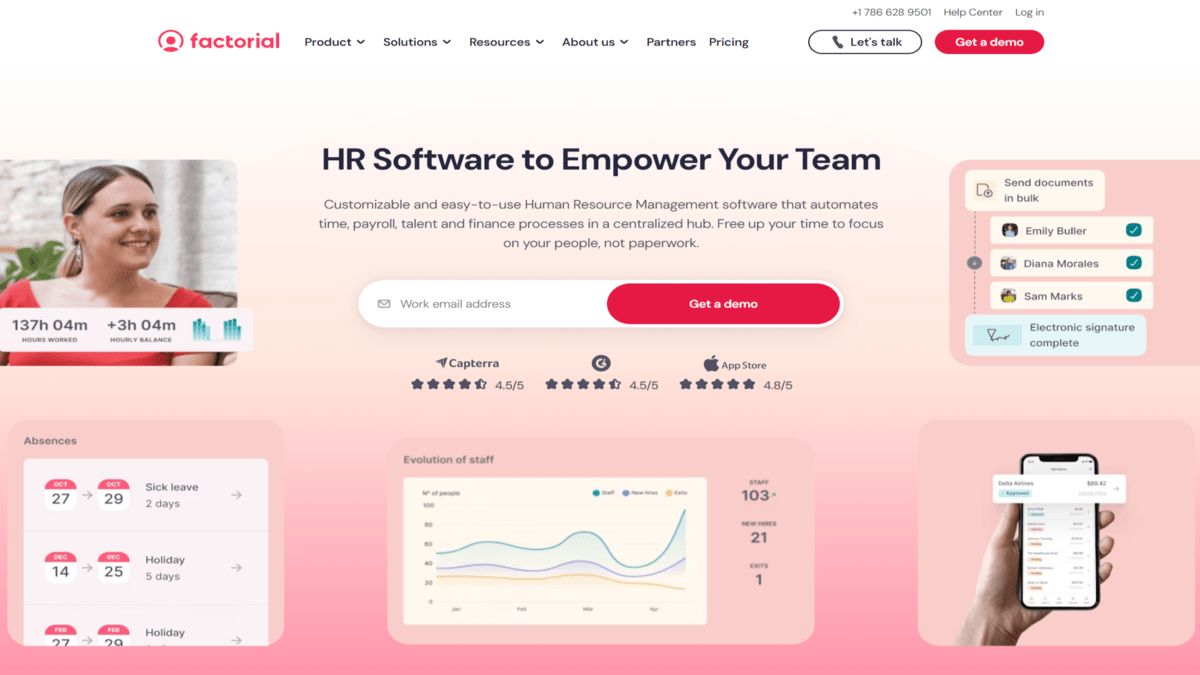
Factorial HR is a cloud-based human resources software that helps businesses manage employee data, payroll, time off, and performance. It streamlines HR processes by offering tools for recruiting, onboarding, document management, and reporting. The platform is designed to improve efficiency and reduce administrative tasks for HR teams. Factorial HR is suitable for small to medium-sized businesses looking to centralize and automate their HR functions.
Key Features:
- Employee Management: Centralize employee records and personal information.
- Time Tracking: Track employee hours and attendance.
- Leave Management: Handle vacation requests and absences.
- Payroll Processing: Manage and automate payroll calculations.
- Performance Reviews: Conduct and manage employee performance evaluations.
- Document Management: Store and manage HR documents securely.
Prcing Details:
Factorial offers a free plan for businesses with up to 10 employees. Its clean interface and focus on core HR processes make it a good option for small businesses looking to digitize their HR operations.
10. Clockify
![]()
Clockify is a free time tracking software that helps individuals and teams monitor work hours and productivity. It offers features like timesheets, project tracking, and reporting to manage tasks and billable hours effectively. The platform is accessible across devices, making it easy for users to log time on the go. Clockify is popular among freelancers, remote teams, and businesses seeking to improve time management and efficiency.
Key Features:
- Time Tracking: Track time spent on tasks and projects.
- Timesheets: Generate and manage detailed timesheets.
- Project Management: Organize and track project progress.
- Reports: Create and view detailed reports on time and productivity.
- Billable Hours: Track and manage billable hours for invoicing.
- Team Management: Monitor and manage team time and attendance.
Pricing Details:
Clockify’s free plan includes features and unlimited users that make it useful for staff management, especially for businesses focused on billable hours or project-based work.
Here are 10 key strategies to effectively manage your staff:

By incorporating these strategies into your management approach, you can create a positive, productive work environment that brings out the best in your staff and drives organizational success.
1. Promote Open Communication
Foster a culture of open communication by getting to know your team members on a personal level. Provide clear channels for employees to communicate with you, especially when bringing up issues. Respect their privacy and try to resolve conflicts constructively.
2. Set Clear Expectations and Goals
Regularly monitor staff performance by setting clear expectations and goals. Provide regular feedback to check if people are meeting targets and company standards. However, avoid micromanaging and find the right balance in your management style.
3. Implement Training and Development
Regular staff training helps identify growth areas and plug skill gaps. Provide opportunities for employees to learn new skills and continually improve performance. Investing in training makes staff feel valued, increases productivity, and helps grow the business.
4. Recognize and Reward Performance
People love to be recognized for their achievements. Implement a rewards system, whether it’s verbal recognition, small gifts, or formal awards. This demonstrates that hard work is appreciated and can motivate staff to maintain a positive workplace culture.
5. Encourage Opinions and Ideas
Empower staff by actively listening to their opinions and ideas. Knowing their input matters is a powerful motivator. Encourage a culture of learning where employees feel comfortable experimenting with new ways of doing their job.
6. Lead by Example
Your behavior as a manager has a trickle-down effect on the entire team. Foster a positive culture by being respectful, hardworking, and professional. If you expect punctuality and strong work ethic from your staff, make sure to model those behaviors yourself.
7. Hire the Right People
Great staff management starts with finding the right candidates who fit the job description, company culture, and team dynamics. Look for qualities like emotional intelligence, reliability, teamwork skills, enthusiasm, and strong work ethic during the hiring process.
8. Delegate Tasks Effectively
Delegating work is crucial for managers. Assign tasks to the right individuals based on their strengths and skills. Provide clear instructions and deadlines, but also give employees the autonomy to complete assignments their own way. Micromanaging can stifle productivity.
9. Provide Constructive Feedback
Offer constructive criticism and feedback in a positive manner to help employees improve. Present feedback in an easy-to-understand way and follow up with ideas for improvement or a plan for moving forward. Feedback should be specific, timely, and focused on behaviors, not personalities.
10. Build Trust and Relationships
Develop a relationship of trust with your employees by being transparent, consistent, and supportive. Actively listen to their concerns, keep your word, and have their back. When staff feel trusted and supported, they are more likely to be engaged, motivated, and loyal to the organization.
Conclusion
As we navigate through 2024, these free online staff management software options offer businesses of all sizes the opportunity to streamline their HR processes and improve team productivity without incurring significant costs. While each system has its strengths and limitations, they all provide valuable tools for effective staff management.
FAQs for 10 Online Staff Management Software
1. What is free staff management software?
Ans: Free staff management software is a digital tool designed to help businesses organize and manage their workforce. It includes features such as employee scheduling, time tracking, task assignments, and communication tools, all available at no cost or under a freemium model, which may offer limited features for free.
2. What are the limitations of free staff management software?
Ans: Free staff management software typically comes with certain limitations, such as:
- Limited Users: Only a small number of employees can be managed.
- Basic Features: Advanced features like in-depth analytics or integrations may be unavailable.
- Storage Constraints: Restrictions on data storage capacity.
- Support: Limited customer support compared to paid plans.
- Advertisements: Presence of ads within the software interface.
3. What types of businesses can benefit from free staff management software?
Ans: Free staff management software is ideal for:
- Small Businesses: Those with a limited number of employees.
- Startups: Organizations looking to minimize costs while organizing their team.
- Retail and Restaurants: Managing shifts and hourly staff efficiently.
- Non-profits: Organizations with budget constraints needing basic scheduling.
- Freelancers and Small Teams: Basic project and time management.
4. What features are commonly available in free staff management software?
Ans: Common features include:
- Employee Scheduling: Create and manage shifts and rotas.
- Time Tracking: Monitor and log hours worked.
- Shift Swapping: Allow employees to exchange shifts.
- Communication Tools: Send messages and notifications.
- Mobile Access: Manage schedules via smartphones and tablets.
5. How secure is free staff management software?
Ans: The security of free staff management software can vary. Most reputable providers offer:
- Data Encryption: Protecting sensitive information.
- Secure Login: Two-factor authentication and password protection.
- Regular Updates: Patching vulnerabilities and improving security.
- Privacy Policies: Clear policies on data handling and user privacy. However, it’s essential to review each provider’s security features before using their services.
6. Can free staff management software integrate with other tools?
Ans: Integration capabilities in free software are often limited but may include:
- Calendar Sync: Integrating with Google or Outlook calendars.
- Payroll Systems: Basic exports to payroll software.
- Email Services: Notifications and alerts via email. For more extensive integrations, a paid version or additional plugins might be required.
7. How do I choose the best free staff management software for my business?
Ans: To choose the best software, consider:
- Business Needs: Match features with your specific requirements.
- User Limitations: Ensure the software can handle your number of employees.
- Ease of Use: Look for a user-friendly interface.
- Customer Support: Check availability and quality of support.
- Reviews and Ratings: Read user reviews to gauge reliability and satisfaction.
8. What are the top free staff management software options?
Ans: Top options include:
- Sling: Focused on scheduling and communication.
- Homebase: Offers scheduling, time tracking, and team communication.
- When I Work: Combines scheduling, time tracking, and attendance.
- Connecteam: Provides task management and communication features.
- Deputy: Offers employee scheduling and time tracking.
- 7shifts: Ideal for restaurants, providing scheduling and shift management.
- Shiftboard: Suitable for managing large and dynamic workforces.
- TSheets by QuickBooks: Time tracking and employee management.
- Humanity: Focused on scheduling and time-off management.
- OpenSimSim: Offers free scheduling and time tracking features.
9. Can I upgrade from the free version of staff management software to a paid version?
Ans: Yes, most free staff management software providers offer premium plans with:
- Additional Features: Advanced scheduling, reporting, and analytics.
- Increased User Limits: Accommodating more employees or locations.
- Enhanced Support: Priority customer service and training.
- No Ads: An ad-free experience. Upgrading is usually a straightforward process through the provider’s website or platform.
10. Are there any hidden costs associated with free staff management software?
Ans: Generally, the free versions do not have direct costs but may have:
- In-App Purchases: Optional features or integrations that require payment.
- Limited Features: Encouraging users to upgrade for full functionality.
- Data Usage: Costs associated with exporting or importing data. Always review the terms of service and pricing pages to understand any potential costs.

